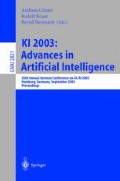Abstract
In this paper we introduce a formalism for solving Hierarchical Task Network (HTN) Planning using Answer Set Programming (ASP). We consider the formulation of HTN planning as described in the SHOP planning system and define a systematic translation method from SHOP’s representation of the planning problem into logic programs with negation. We show that our translation is sound and complete: answer sets of the logic program obtained by our translation correspond exactly to the solutions of the planning problem. We compare our method to (1) similar approaches based on non-HTN planning and (2) SHOP, a dedicated planning system. We show that our approach outperforms non-HTN methods and that its performance is better with ASP systems that allow for nonground programs than with ASP systems that require ground programs.
Access this chapter
Tax calculation will be finalised at checkout
Purchases are for personal use only
Preview
Unable to display preview. Download preview PDF.
References
Niemelä, I., Simons, P.: Efficient Implementation of the Well-founded and Stable Model Semantics. In: Maher, M. (ed.) Proceedings of the Joint International Conference and Symposium on Logic Programming, Bonn, Germany, pp. 289–303. The MIT Press, Cambridge (1996)
Dimopoulos, Y., Nebel, B., Koehler, J.: Encoding Planning Problems in Nonmonotonic Logic Programs. In: Steel, S. (ed.) ECP 1997. LNCS, vol. 1348, pp. 169–181. Springer, Heidelberg (1997)
Dix, J., Furbach, U., Niemelä, I.: Nonmonotonic Reasoning: Towards Efficient Calculi and Implementations. In: Voronkov, A., Robinson, A. (eds.) Handbook of Automated Reasoning, pp. 1121–1234. Elsevier-Science-Press, Amsterdam (2001)
Eiter, T., Leone, N., Mateis, C., Pfeifer, G., Scarcello, F.: The KR System dlv: Progress Report, Comparisons and Benchmarks. In: Cohn, A.G., Schubert, L., Shapiro, S.C. (eds.) Proceedings Sixth International Conference on Principles of Knowledge Representation and Reasoning (KR 1998), pp. 406–417. Morgan Kaufmann, San Francisco (1998)
Chen, W., Warren, D.S.: Tabled Evaluation with Delaying for General Logic Programs. Journal of the ACM 43, 20–74 (1996)
Rao, P., Sagonas, K., Swift, T., Warren, D.S., Freire, J.: XSB: A System for Efficiently Computing Well-Founded Semantics. In: Fuhrbach, U., Dix, J., Nerode, A. (eds.) LPNMR 1997. LNCS(LNAI), vol. 1265, pp. 430–440. Springer, Heidelberg (1997)
Apt, K.R., Marek, V., Truszczynski, M., Warren, D.S. (eds.): The Logic Programming Paradigm: Current Trends and Future Directions. Springer, Berlin (1999)
Sacerdoti, E.: A Structure for Plans and Behavior. American Elsevier Publishing, Amsterdam (1977)
Erol, K., Hendler, J., Nau, D.: UMCP: A Sound and Complete Procedure for Hierarchical Task-Network Planning. In: Hammond, K. (ed.) Proceedings of AIPS 1994, Chicago, IL, pp. 249–254. AAAI Press, Menlo Park (1994)
Wilkins, D.: Practical Planning – Extending the Classical AI Planning Paradigm. Morgan Kaufmann, San Francisco (1988)
Nau, D., Cao, Y., Lotem, A., Mun̈oz-Avila, H.: SHOP: Simple Hierarchical Ordered Planner. In: Dean, T. (ed.) Proceedings of IJCAI 1999. Morgan Kaufmann, San Francisco (1999)
Nau, D., Cao, Y., Lotem, A., Muñoz-Avila, H., Mitchell, S.: Total-Order Planning with Partially Ordered Subtasks. In: Nebel, B. (ed.) Proceedings of IJCAI 2001, Seattle, Washington, pp. 425–430. Morgan Kaufmann, San Francisco (2001)
Gelfond, M., Lifschitz, V.: Action Languages. Electronic Transactions on AI 2, 193–210 (1998)
Turner, H.: Representing Actions in Logic Programs and Default Theories: A Situation Calculus Approach. The Journal of Logic Programming 31, 245–298 (1997)
Lifschitz, V.: Action Languages, Answer Sets and Planning. In: Apt, K.R., Marek, V.W., Truszczynski, M., Warren, D.S. (eds.) The Logic Programming Paradigm: A 25-Year Perspective, pp. 357–373. Springer, Heidelberg (1999)
McCain, N., Turner, H.: Causal Theories of Action and Change. In: Proceedings of the 14th National Conference on Artificial Intelligence (AAAI 1997), Menlo Park, CA, pp. 460–465. AAAI Press, Menlo Park (1997)
McCain, N.: Using Causal Calculator with the C Input Language. Technical report, University of Texas at Austin (1999)
Eiter, T., Faber, W., Leone, N., Pfeifer, G., Polleres, A.: The DLV-K Planning System: Progress Report. In: Flesca, S., Greco, S., Leone, N., Ianni, G. (eds.) JELIA 2002. LNCS (LNAI), vol. 2424, pp. 541–544. Springer, Heidelberg (2002)
Baral, C., Tran, N., Tuan, L.: Reasoning about Actions in a Probabilistic Setting. In: AAAI/IAAI 2002, pp. 507–512. AAAI Press, Menlo Park (2002)
Son, T., Baral, C., McIlraith., S.: Planning with domain-dependent knowledge of different kinds – an answer set programming approach. In: Eiter, T., Faber, W., Truszczyński, M. (eds.) LPNMR 2001. LNCS (LNAI), vol. 2173, pp. 226–239. Springer, Heidelberg (2001)
Nau, D., Au, T.C., Ilghami, O., Kuter, U., Murdock, W., Wu, D., Yaman, F.: SHOP2: an HTN planning system. Journal of Artificial Intelligence Research (2003) (to appear)
Dix, J., Kuter, U., Nau, D.: HTN Planning in Answer Set Programming. Technical Report CS TR 4336, University of Maryland (2002) (submitted for publication)
Bacchus, F.: AIPS 2000 Planning Competition. AI Magazine 22, 47–56 (2001)
Kvarnström, J., Doherty, P.: TALplanner: A Temporal Logic Based Forward Chaining Planner. Annals of Mathematics and Articial Intelligence 30, 119–169 (2001)
Author information
Authors and Affiliations
Editor information
Editors and Affiliations
Rights and permissions
Copyright information
© 2003 Springer-Verlag Berlin Heidelberg
About this paper
Cite this paper
Dix, J., Kuter, U., Nau, D. (2003). Planning in Answer Set Programming Using Ordered Task Decomposition. In: Günter, A., Kruse, R., Neumann, B. (eds) KI 2003: Advances in Artificial Intelligence. KI 2003. Lecture Notes in Computer Science(), vol 2821. Springer, Berlin, Heidelberg. https://doi.org/10.1007/978-3-540-39451-8_36
Download citation
DOI: https://doi.org/10.1007/978-3-540-39451-8_36
Publisher Name: Springer, Berlin, Heidelberg
Print ISBN: 978-3-540-20059-8
Online ISBN: 978-3-540-39451-8
eBook Packages: Springer Book Archive

